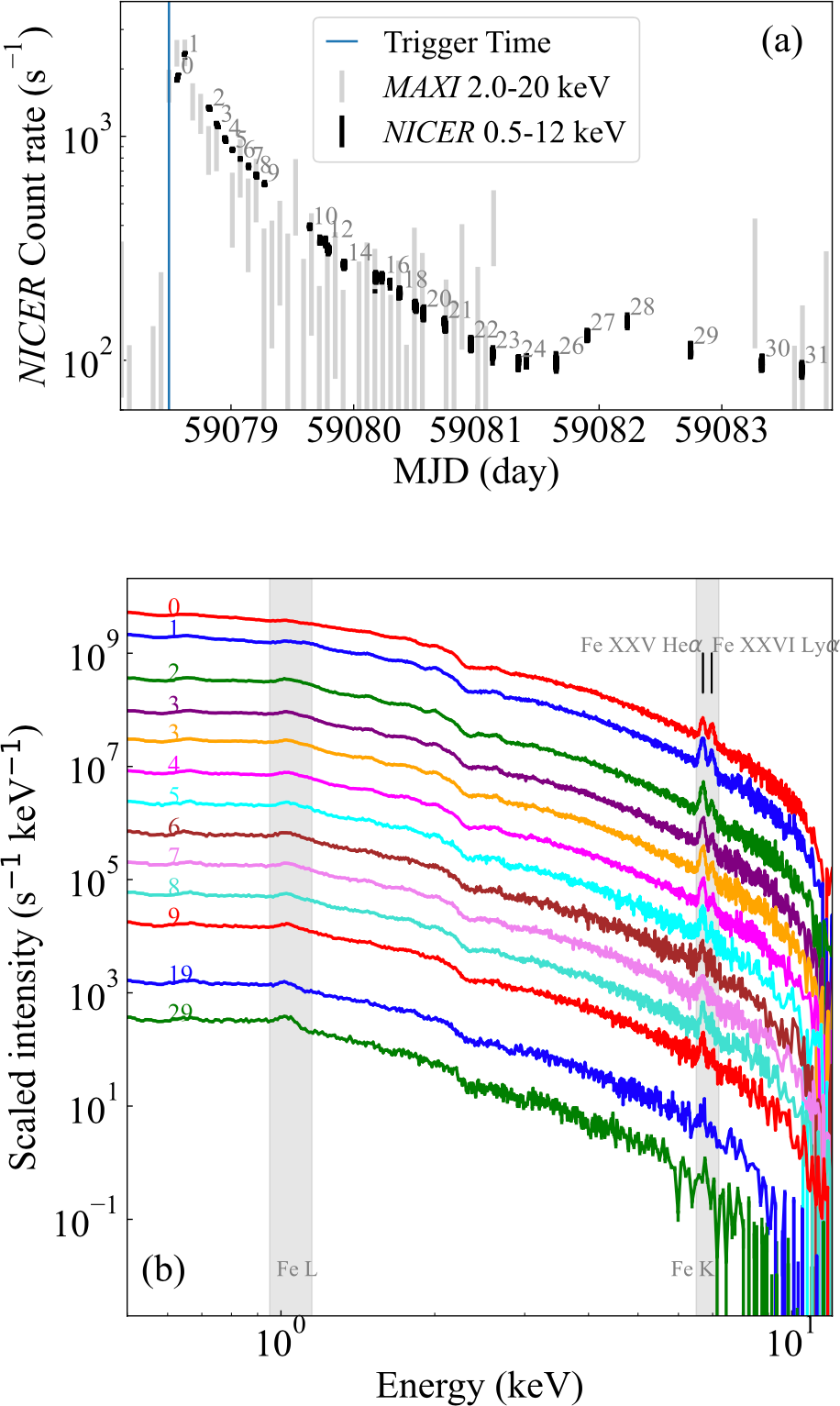NICER / ISS Science Nugget
for March 21, 2024
Capturing the Rising Phase of a Giant Stellar Flare
Most of the matter in the universe exists in plasma form - a hot stew of ionized atoms and free electrons. And most of that plasma is in a steady state of equilibrium, in which (at a fixed temperature and where the external radiation environment is benign) the number of collisionally induced ionizations equals the number of ion-electron recombinations. In highly dynamic situations, however - such as explosive events - this equilibrium can be disrupted. At million-degree temperatures, atoms become highly ionized (losing most of their electrons), and for heavy atoms in these states the electron energy-level transitions produce (and absorb) X-ray photons at characteristic energies; thus, X-ray observations can identify and quantify the presence of individual chemical elements in the plasma through these spectroscopic "fingerprints."
Such conditions exist in the coronae - the outermost, extended atmospheres - of active stars, like our Sun. Stellar coronae are energized by magnetic fields, twisting, looping, and sometimes reorganizing themselves in so-called "reconnection" events that explosively accelerate electrons, producing electromagnetic and particle radiation in a stellar flare. Probing the earliest parts of these events, before the plasma achieves ionization equilibrium, with X-ray spectroscopy to better understand the flare mechanism has been a long-sought goal, but the unpredictability of flare occurrences makes dynamic observations difficult.
The combination of the MAXI and NICER payloads on ISS provides a novel opportunity to address this challenge. In a paper recently accepted for peer-reviewed publication in The Astrophysical Journal, M. Kurihara (Univ. of Tokyo) and collaborators describe MAXI's detection of a flare from the binary star system UX Ari in August 2020, which triggered (via ground communication) prompt follow-up with NICER, beginning on the very next ISS orbit. The NICER campaign enabled time-dependent spectra to be collected, which revealed (among other things) emission lines from iron atoms ionized at different levels. The ratio of the strengths of these iron lines, and how it changes with time, probes the state of the corona plasma. Kurihara et al. describe the flare as being 10x more energetic than any previously observed from UX Ari in X-rays, estimate the flare magnetic loop size to be approximately 3 billion meters (about 2.5x the Earth-to-Moon distance), and show that the plasma temperature peaks before the X-ray brightness does, which suggests that the interval of plasma formation in the flare loop was captured by the observations. While the decay trend is consistent with the standard model for eruptive flares and a plasma in ionization equilibrium, the earliest NICER snapshots prior to the flare's peak show some evidence for out-of-equilibrium conditions. Future observations, perhaps triggered even more quickly with the automated OHMAN system, could provide unambiguous measurements of fleeting and elusive non-equilibrium plasmas in stellar flares.

a) Measurements of the evolving X-ray brightness of the binary star system UX Ari, made using the MAXI (grey bars) and NICER (numbered black bars) payloads beginning on 17 August, 2020. The two instruments are sensitive to overlapping but distinct ranges of X-ray photon energies (shown in kiloelectronvolts, keV). The measurement points are generally separated by the 90-min ISS orbit, with NICER observations beginning one orbit after the MAXI trigger. b) A series of NICER spectra, numbered according to panel a), demonstrate changes to emission features associated with ionized iron atoms, most notably in the ratio of line strengths between iron atoms that have lost all but two of their electrons (Fe XXV) and all but one of their electrons (Fe XXVI). For clarity, successive spectra are vertically offset by a constant factor in this plot. (Figure credit: Kurihara et al. 2024)
<< Previous
Main Index
Next >>